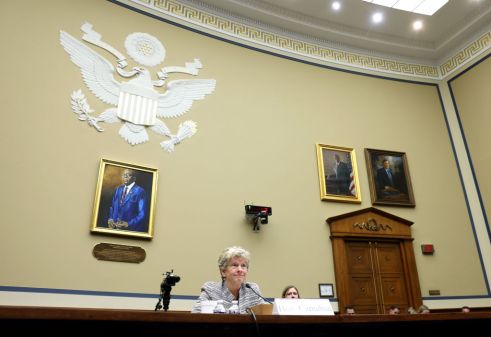GSA IG: 18F’s financial projections need a rework
The General Services Administration’s 18F has seen a cumulative net loss of more than $31 million between fiscal year 2014 and the third quarter of fiscal year 2016, a report released Monday from the agency’s inspector general has found.
The inability to recover costs came from “18F’s inaccurate financial projections, increased staffing levels, and the amount of staff time spent on non-billable activities,” the report reads.
The evaluation started in December 2015, according to a release on the report, “after several senior GSA officials expressed concerns about the management of 18F to the OIG.”
Lawmakers have in the past expressed concerns about 18F’s little-defined role in the federal IT space and called for greater organizational transparency.
[Read more: Lawmakers crave transparency from USDS, 18F digital teams]
The report details how 18F operated at an increasing deficit, where staffing continued to balloon at the organization despite gaining smaller revenues than anticipated.
“18F senior managers have established a pattern of overestimating revenue projections,” according to the release.
An example: Projected annual revenue for fiscal year 2014 was $4.76 million, but the year closed with a grand total of zero revenue billed or collected, according to the report.
The report also found 18F’s billing process was not always accurate and resulted in “a series of inaccurate charges to their clients.”
“If billing discrepancies are left unresolved, GSA could be held accountable for augmenting appropriations for other federal agencies,” the release says.
Breaking even
The report found internal discussions among senior management “that raise doubts about their intent to break even.”
“To be frank, there are some of us that don’t give rip about the losses,” said 18F’s director of operations in February when 18F management was discussing three breakeven scenarios.
And in response, the report notes Regional Administrator for GSA’s Region 9, Andrew McMahon said, “Sure, in the end, I could care less. ASF loses money all over the place. That’s the decision we should reiterate with Denise [GSA Administrator Roth], do you care about losing +$2.5M in order to bring in 100 more great hired [sic] into government?”
The report also details in particular an internal struggle on one approach potentially breaking even more quickly: freezing hiring.
From April 2014 to March 2016, the 18F staff expanded from 33 to 201 full time employees.
Federal Acquisitions Service Commissioner Thomas Sharpe advised Administrator Denise Turner Roth and the former Technology Transformation Service Commissioner at least three times to pause hiring, but the IG found through internal records that 18F management and the administrator’s office did not support it.
Roth wrote to Sharpe in January 2016, “Demand for 18F services continues to be strong, the utilization rate is increasing, and there is other activity in place that justifies staying the course on hiring at this time,” according to the report.
The report says former Executive Director Aaron Snow said “18F continued to hire to meet demand for projects because they did not have the staff in place to accept all project requests. Also, he wanted to ensure 18F had enough staff to mitigate the impact of occasional staff turnover.”
The OIG also found that staff spent little time working on projects billed to federal agencies — less than half of their time.
The report notes 18F’s timekeeping system showed that nonbillable time was spent on activities such as “outreach promoting 18F projects and accomplishments, developing an 18F brand and developing an internal timekeeping system.”
What’s next?
GSA management agreed with the report’s seven recommendations and told the OIG they had intentions to take action.
The report’s seven recommendations were for GSA leadership to:
o Establish a viable plan to ensure full cost recovery of Acquisition Services Fund monies expended by 18F;
o Ensure that internal 18F projects have appropriate supervisory review;
o Implement controls over 18F’s reimbursable agreement process to ensure that work is not performed outside of a fully executed agreement;
o Ensure that GSA CIO reviews and approves, in writing, all 18F IT-related work performed for GSA internal organizations;
o Implement a comprehensive review of 18F’s past work to ensure accuracy of all billings;
o Establish reliable internal controls to ensure that 18F’s future billings are accurate; and
o Ensure that 18F’s billing records are retained in accordance with GSA records management standards.
In response, 18F’s Dave Zvenyach writes in a blog post that the office has taken numerous steps to correct the issues brought up in the report: “We take these issues seriously and have taken significant steps to strengthen 18F’s operations.”
The blog post states the office has instituted dashboards for real-time management of financial performance and staff utilization, conducted a reconciliation of past agreements to ensure accurate billing and “standardized the relationship between 18F and the CIO by, among other things, having a CIO lead who reviews all internal technology projects for 18F.”
“Our mission requires us to be relentlessly focused on helping our agency partners, and that means we need to ensure that we continuously improve on our controls and processes to meet that mission,” the blog post reads.
Snow recently told FedScoop 18F’s long-term impact is about more than money — particularly in things that are “intangible.”
“The measure of 18F’s value is not just the dollars saved on the projects we’re working on right now with an agency any more than the measure of its value is the number of dollars it makes or loses,” he said then. “The measure of its value is how much we help agencies evolve how they think about the delivery of digital services in government across all of their work.”
“And I don’t think anybody has done a fantastic job yet of measuring the success of the intangibles that we are ultimately after,” he added.
At the time, Snow also said 18F is going to be around for a long time, in spite of a changing administration.
“It seems clear there is support for what we do from all sides, all points on the political spectrum,” he said then. “I don’t think that a change in administration substantially changes what we do, how we do it or the scale of impact we can have.”
[Read more: Aaron Snow sees bright future for evolving 18F]





